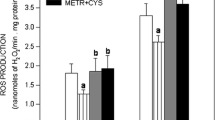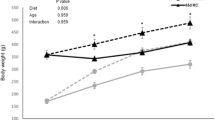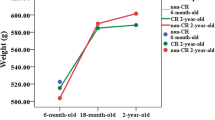Abstract
Life long dietary restriction has a variety of beneficial effects such as retarding the age-related decline of physiological functions as well as the onset of diseases, thus prolonging the life span of experimental animals. In the present work we investigated the effect of DR initiated late in life on rats regarding oxidative modifications of liver mitochondrial proteins in terms of generation of carbonyl moieties by western blot using antibodies against dinitrophenylhydrazones after the reaction of the proteins with dinitrophenylhydrazine. Protein carbonyls in mitochondria of 30-month-old animals increased by about 55% as compared with their 10-month-old counterparts. Every-other-day feeding initiated at the age of 26.5 months and continued for 3.5 months resulted in the decrease of the carbonyls to the level of the ad libitum fed young animals. Our findings suggest that DR initiated late in life can have a beneficial effect by reducing the accumulated oxidative damage in mitochondrial proteins.
Similar content being viewed by others
References
Aloso E and Rubo V (1995) Affinity cleavage of carbamoylphosphate synthetase β localizes regions of the enzyme interacting with the molecule of ATP that phosphorylates carbamate. Eur J Biochem 229: 377–384
Aloso E, Cervera J, Garcia-Espana A, Bendala E and Rubio V (1992) Oxidative inactivation of carvamoyl phosphate synthetase (ammonia) Mechanism and sites of oxidation, degradation of the oxidized enzyme, and inactivation by glycerol, EDTA, and thiol protecting agents. J Biol Chem 267: 4524–4532
Ames BN, Shigenaga MK and Hagen TM (1993) Oxidants, antioxidants, and the degenerative diseases of aging. Proc Natl Acad Sci USA 90: 7915–7922
Beckman KB and Ames BN (1998) The free radical theory of aging matures. Physiol Rev 78: 547–581
Barogi S, Baracca A, Parenti CG, Bovina C, Formiggini G, Marchetti M, Solaini G and Lenaz G (1995) Lack of major changes in ATPase activity in mitochondria from liver, heart, and skeletal muscle of rats upon ageing. Mech Ageing Dev 84: 139–150
Cao G and Cutler RG (1995) Protein oxidation and aging. I. Difficulties in measuring reactive protein carbonyls in tissue using 2,4-dinitrophenylhydrazine. Arch Biochem Biophys 320: 106–114
Chance B, Sies H and Boveris A. (1979) Hydroperoxide metabolism in mammalian organs. Physiol Rev 59: 527–605
Chen JJ and Yu BP (1994) Alterations in mitochondrial membrane fluidity by lipid peroxidation products. Free Radic Biol Med 17: 411–418
Clark S (1976) A major polypeptide component of rat liver mitochondria: Carbamyl phosphate synthetase. J Biol Chem 251: 950–961
Goodell SC and Cortopassi GA (1998) Analysis of oxygen consumption and mitochondrial permeability with age in mice. Mech Ageing Dev 101: 245–256
Goto S and Nakamura A (1997) Age-associated, oxidatively modi-fied proteins: A critical evaluation. Age 20: 81–89
Hagen TM, Yowe DL, Bartholomew JC, Wehr CM, Do KL, Park JY and Ames BN (1997) Mitochondrial decay in hepatocytes from old rats: membrane potential declines, heterogeneity and oxidants increase. Proc Natl Acad Sci USA 94: 3064–3069
Halliwell B and Gutteridge JM (1986) Oxygen free radicals and iron in relation to biology and medicine: some problems and concepts. Arch Biochem Biophys 246: 501–514
Harman D (1956) Aging: a theory based on free radical and radiation chemistry. J Gerontol 2: 289–300
Ishigami A and Goto S (1990) Effect of dietary restriction on the degradation of proteins in senescent mouse liver parenchymal cells in culture. Arch Biochem Biophys 283: 362–366
Johnson D and Lardy H (1967) Isolation of liver and kidney mitochondria. Methods Enzymol 10: 94–96
Kaneko T, Tahara S and Matsuo M (1996) Nonlinear accumulation of 8-hydroxy-2-deoxyguanosine, a marker of DNA damage, during aging. Mutation Res 316: 277–285
Kaneko T, Tahara S and Matsuo M (1997) Retarding effect of dietary restriction on the accumulation of 8-hydroxy-2-deoxyguanosine in organs o Fischer 344 rats during aging. Free Radic Biol Med 23: 76–81
Laganiere S and Yu BP (1994) Effect of chronic food restriction in aging rats. I. Liver subcellular membranes. Mech Ageing Dev 48: 207–219
Lass A, Sohal BH, Weindruch R, Forster MJ and Sohal RS (1998) Caloric restriction prevents age-associated accrual of oxidative damage to mouse skeletal muscle mitochondria. Free Radic Biol Med 25: 1089–1097
Lee J, Yu BP and Herlihy JT (1999) Modulation of cardiac mitochondrial membrane fluidity by age and calorie intake. Free Radic Biol Med 26: 260–265
Lenaz G (1998) Role of mitochondria in oxidative stress and ageing. Biochim Biophys Acta 1366: 53–67
Levine RL, Garland D, Oliver CN, Amici A, Climent I, Lenz AG, Ahn BW, Shaltiel S and Stadtman ER (1990) Determination of carbonyl content in oxidatively modified proteins. Methods Enzymol 186: 464–478
Linnane AW, Maruzuki S, Ozawa T and Tanaka M (1989) Mitochondrial DNA mutations as an important contributor to ageing and degenerative diseases. Lancet i: 642–645
Martin GM, Austad SN and Johnson TE (1996) Genetic analysis of ageing: role of oxidative damage and environmental stresses. Nature Genetics 13: 25–34
Martinez M, Hernandez AI, Martinez N and Ferrandiz ML (1996) Age-related increase in oxidized proteins in mouse synaptic mitochondria. Brain Res 731: 246–248
Masoro EJ (1995) Design Issue in the use of the diet-restricted rodent model. In: Hart RW et al. (eds) Dietary Restriction, pp 41–50. ILSI Press, Washington
Nakamura A and Goto S (1996) Analysis of protein carbonyls with 2,4-dinitrophenyl hydrazine and its antibodies by immunoblot in two-dimensional gel electrophoresis. J Biochem 119: 768–774
Sastre J, Pallardó FV, Plá R, Pell A, Juan G, O'Connor JE, Estrela JM, Miquel J and Vi J (1996) Aging of the liver: age-associated mitochondrial damage in intact hepatocytes. Hepatology 24: 1199–1205
Shigenaga MK, Hagen TM and Ames BN (1994) Oxidative damage and mitochodrial decay in aging. Proc Natl Acad Sci USA 91: 10771–10778
Sohal RS and Dubey A (1994) Mitochondrial oxidative damage, hydrogen peroxide release, and aging. Free Radic Biol Med 16: 621–626
Sohal RS, Sohal BH and Orr WC (1995) Mitochondrial superoxide and hydrogen peroxide generation, protein oxidative damage, and longevity in different species of flies. Free Radic Biol Med 19: 499–504
Sokal RR and Rohlf FJ (1981) Biometry, 2nd ed.WA Freeman, New York
Stadtman ER (1992) Protein oxidation and aging. Science 257: 1220–1224
Starke-Reed PE and Oliver CN (1989) Protein oxidation and proteolysis during aging and oxidative stress. Arch Biochem Biophys 275: 559–567
Takahashi R and Goto S (1987) Influence of dietary restriction on accumulation of heat-labile enzyme molecules in the liver and brain of mice. Arch Biochem Biophys 257: 200–206
Tauchi H and Sato T (1968) Age changes in size and number of mitochondria of human hepatic cells. J Gerontol 23: 454–461
Weindruch R and Walford RL (1982) Dietary restriction in mice beginning at 1 year of age: Effect on life-span and spontaneous cancer incidence. Science, 215: 1415–1418
Wilson PD and Franks LM (1975) The effect of age on mitochondrial ultrastructure and enzymes. Adv Exp Med Biol 53: 171–183
Yan L-J, Levine RL and Sohal RS (1997) Oxidative damage during aging targets mitochondrial aconitase. Proc Natl Acad Sci USA 94: 11168–11172
Yu BP, Chen JJ, Kang CM, Choe M, Maeng, YS and Kristal BS (1996) Mitochondrial aging and lipoperoxidative products. In: Kitani K, Aoba A and Goto S (eds) Pharmacological Intervention in Aging and Age-associated Disorders. Ann NY Acad Sci Vol 786, 44–56. The New York Academy of Sciences, New York
Author information
Authors and Affiliations
Rights and permissions
About this article
Cite this article
Nagai, M., Takahashi, M. & Goto, S. Dietary restriction initiated late in life can reduce mitochondrial protein carbonyls in rat livers: Western blot studies. Biogerontology 1, 321–328 (2000). https://doi.org/10.1023/A:1026590819033
Issue Date:
DOI: https://doi.org/10.1023/A:1026590819033




